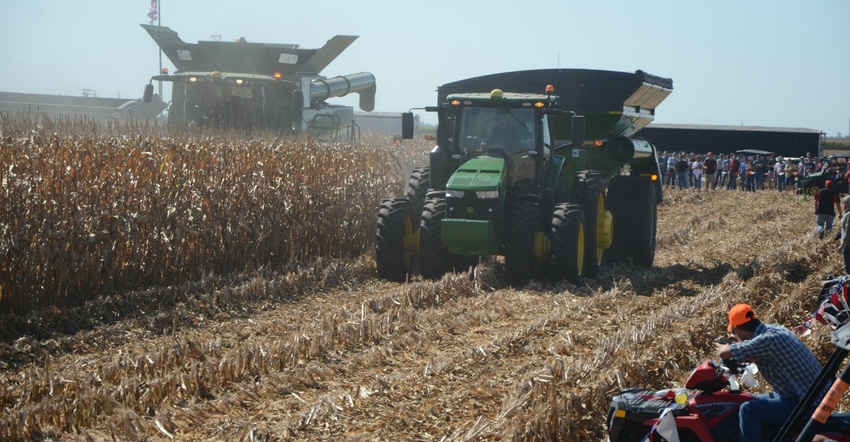
Field demonstrations are one of the biggest draws every year at Husker Harvest Days, giving visitors a chance to see the latest harvesting, tillage and hay equipment in action — and compare it side-by-side with other equipment on the show site's 300 acres of corn and alfalfa.
However, there are some big changes coming to field demos this year. In previous years, demos involved two passes of each combine and took place once each day from 11 a.m. to 1 p.m.
This year, combine demos will run twice daily — rather than once, as they have in years past. In addition, each combine will make a single pass at each demo instead of two.
Combines demos will take place for one hour in the morning, from 10:30 to 11:30 a.m., followed by tillage demos from 11:30 a.m. to 12:30 p.m. Then, combines and tillage equipment will make another pass at 1 p.m., followed by hay demos at 2 p.m.
Jason Luebbe, host farmer at HHD, hopes the change will give visitors that don't arrive in time for morning demos a chance to see combines in the field later in the day.
"We've heard from people walking in at 1 o'clock in the afternoon asking, 'When do combine demos start?' Some exhibitors have asked as well," Luebbe says. "I think it will work very well. We'll leave the combines out in the field, and visitors will have a chance to walk around the machine, talk with dealers, and then watch it run again later if they want."
"It takes a while to get filtered through the show, and it's easy to get caught up in the event and realize you've missed a demo," show manager Matt Jungmann says. "Splitting demos up gives visitors two opportunities to go see each combine."
Take note of demo times, locations
Because combines are making a single pass each demo, it's recommended that visitors show up on time or before demos start. With the recently constructed perimeter fence surrounding the exhibit field, keep in mind which field will be harvested that day — and which gate you need to exit through.
"Be sure to take a look at the map, which has gate numbers listed on it," Jungmann says. "You'll want to figure out which gate is closest, so you don't end up wandering around the outside of the exhibitor field trying to find the demos."
On Tuesday, combine demos will take place on Field 4. So, it would be best to leave through Gates 5 or 6 on the northwest side of the exhibit field. On Wednesday, demos will take place on Field 1, northwest of the exhibit field, so exit through Gate 6. On Thursday, demos will be on Field 5, so leave through Gate 4 or 5 on the south and west side of the exhibit field.
Meanwhile, after about 15 years in the field just west of the exhibit field, hay demos will take place from 2 to 3 p.m. each day in a new location — on a newly seeded alfalfa field on Field 2, just north of Gate 7 on the north side of the exhibit field, and just east of the grain handling area.
Strip-till demonstrations and self-propelled sprayer ride 'n' drive times also have changed. Both will run from 10 a.m. to 3 p.m. each day of the show in Field 3, northeast of the exhibit field, just north of Gate 8.
These demonstrations and ride 'n' drives give equipment companies an opportunity to conduct their own independent demonstrations as requested by customers — and give visitors a chance to see an independent demonstration. So, if there's a strip-till unit or sprayer you'd like to see at work, check with a company representative.
"It gives companies a playground to do their own demos and show off their equipment," Jungmann says. "It's what separates HHD from a static indoor show farm. It gives them a chance to put a customer in the seat of a sprayer."
About the Author(s)
You May Also Like






